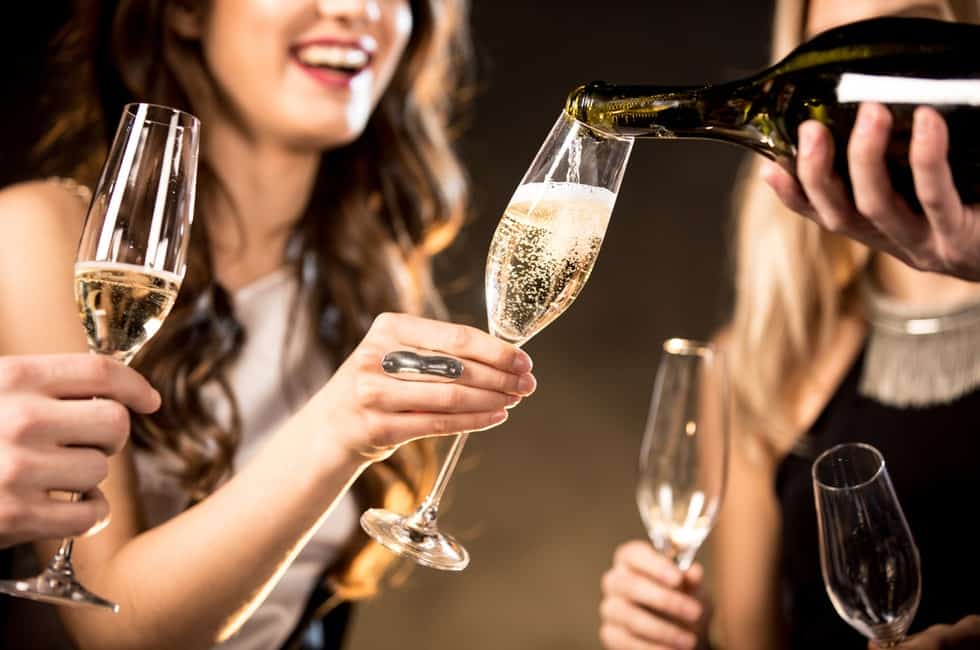Umm, no bubbles are not what add sweetness. Otherwise all champagnes would taste the same in regards to sweetness.
Drinking champagne straight up, I tend to like less sweet champagnes.
In regards to mimosa, the most important factor is the balance of OJ and champagne. The acidity of the OJ can balance out a too sweet champagne while OJ can overwhelm a less sweet champagne and the mimosa could come off as heavy.
For champagnes you have to look at the label to figure out the sweetness...
Brut vs Extra Dry: What’s the Difference?
Written by
Saurabh in
Wine Info
The Brut and Extra Dry are the most popular champagnes around the world. Some casual stores don’t even sell other types of champagne rather than these two. They both taste sour, while some may say that they are a little bitter.
What is the difference between Brut and Extra Dry?
Anyways, the main difference between Brut and Extra Dry champagne is the level of sweetness in the beverage. It may sound weird, but the Extra Dry champagne is considered to be sweeter than the Brut one.
Brut means “dry” or “raw” in French. It makes sense, as this champagne itself tastes pretty dry and just 1.5% consists of sugar.
This is the most common champagne, and someone who has never tried before would not even realize that there is sugar added in his drink. People who like dry wine are highly suggested to try the Brut champagne as well. After tasting Brut, some even choose it over the wine they were used to drink.
Extra Dry champagne is a little odd because of its name. Why’s that? Well, this type of champagne is actually sweeter than the Brut one, even though its name defines the opposite.
The sugar level of this champagne can go up to 2%. Although the difference is very slight, a lot of people notice it. Extra Dry also tastes less sour than Brut, and the sweetness definitely plays its role in that part.
Check: Does Champagne go Bad
Brut or Extra Dry Champagne
As mentioned, a lot of people would be surprised to hear that Extra Dry champagne is actually sweeter than the Brut one. It’s hard to pick between those two types, as most of the things depend on the person who drinks the beverage and, of course, his taste.
Still, it is essential to know that neither of these two is extremely sweet like Demi-Sec or Doux. Usually, most of the champagnes are dry, and very few people would complain of them being too sweet. Now let’s go to the details.
On the other hand, if you want your champagne to be a little drier, rather then balanced up with the sweetness, then you would really love the Brut. The amount of sugar in it is so imperceptible that you will not even notice it.
Your choice may also depend on the occasion or event you are getting the champagne for. Is it a business meeting? New Year’s Eve or maybe a birthday party? Most people buy the Extra Dry champagnes for Christmas, Birthdays or National Holidays, while Brut champagnes are mostly consumed during more personal events, like dates and meetings.
Champagne Sweetness
Champagne is not the sweetest beverage to drink. However, some of its types differ from one another in the manner of sweetness. Here is the scale of champagnes going from the driest ones to the sweetest.
If you want to try dry champagne, here are some that are highly recommended.
Brut Nature – It just has 0-3 g/l Residual Sugar (RS), which is equivalent to less than 1/6 teaspoon sugar per 5 oz/150 ml serving. This is the driest type of champagne and is recommended for people who admire dry beverages.
Extra Brut – This brut-type champagne has 0-6 g/l RS, which is equivalent to less than ¼ teaspoon sugar per 5 oz/150 ml serving. Extra Brut is a little drier than the Brut. It also is sourer, so you can taste it out to feel the difference.
Brut – The original Brut has 0-12 g/l RS, which is equivalent to less than ½ teaspoon sugar per 5 oz/150 ml serving.
Now let’s get sweeter. Here are some types of champagnes that will satisfy your lack of sweetness.
Extra Dry – This one has 12-17 g/l RS, which is equivalent to ½–¾ teaspoon sugar per 5 oz/150 ml serving. After all, it turns out that the Extra Dry champagne’s least possible grams of residual sugar (12g) is the maximum you can get from the Brut champagne.
Dry – This champagne has 17-32 g/l RS is equivalent to ¾-1 teaspoon sugar per 5 oz/150 ml serving. A little sweeter than the previous one.
Demi-Sec – Now we got to the really sweet ones. Demi-Sec has 32-50 g/l RS is equivalent to 1–2 teaspoons sugar per 5 oz/150 ml serving. Now it goes even sweeter up to the end.
Doux – This is probably the sweetest type of champagne you get if you have a passion for sweet beverages. It has 50+ g/l RS is equivalent to over 2 teaspoons sugar per 5 oz/150 ml serving. It almost tastes like a cream soda and is worth for trying out.

